- Author Matthew Elmers [email protected].
- Public 2023-12-16 21:49.
- Last modified 2025-01-24 09:17.
Castle outside, castle inside
Nobody knows what the Gluboka castle was like in the 13th century, when it had a tower surrounded by a wall. It is only known that it stood on the site of the modern main tower of the castle with a clock. Then in the XV century. it was rebuilt in the late Gothic style. Its defense capacity was improved by the construction of a bastion pushed forward with its own kitchen, which was connected to the castle by means of an underground passage.
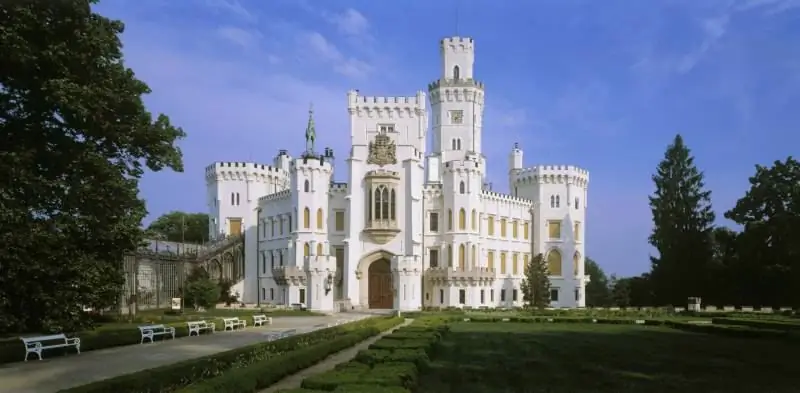
Hluboka Castle. It's still early in the morning and all the tourists are still sleeping …
In the second half of the XVI century. Gluboka was once again rebuilt in the form of a three-story castle with three courtyards, a chapel with paintings, outbuildings and outer walls with towers. This is how the artist Willenberg portrayed him, so we know how he looked then at least so, but we know. Over the next 30 years, it was completed and rebuilt until Don Balthasar de Marradas got it, who rebuilt it in the late Renaissance style.
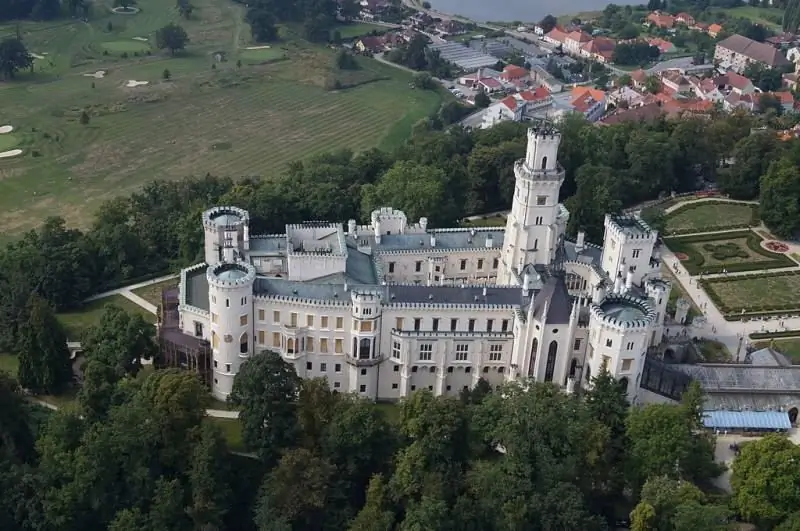
Bird's eye view of the castle.
The new owner, Jan-Adolph the First of the Schwarzenberg family, from 1665 expanded and improved the castle park, which had been started during the Thirty Years War, and ordered the construction of a new residential wing above the stable. His son Ferdinand-Eusebius modernized the heating system of the castle. He ordered to break the old medieval fireplaces, which required a huge amount of firewood, and put the tiled stoves, which were fired from the service rooms or corridors located behind the master's apartments.
In 1707-1721. Prince Adam-Franz Schwarzenberg ordered to rebuild the castle in the spirit of the late Baroque. The result was a magnificent Baroque residence with a representative hall, on the ceiling of which, for the Emperor's visit, a painting was made glorifying the Schwarzenberg family. However, this visit of the emperor for the Schwarzenberg family ended tragically: on June 11, 1732, while hunting, Emperor Charles VI accidentally shot Adam-Franz, who died from his wound on the same day. Therefore, the reconstruction of the castle was already completed by his mother, Eleanor-Amalia.
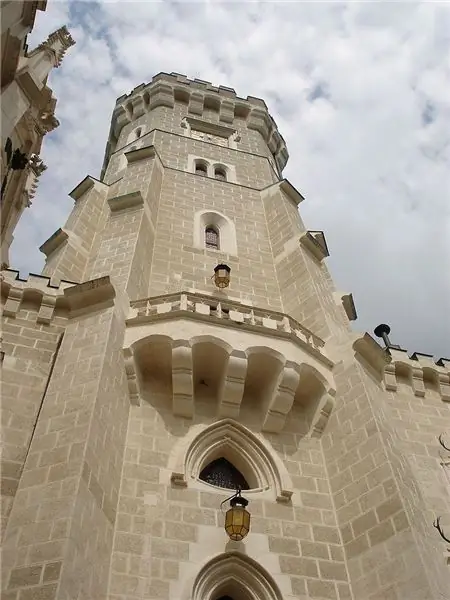
The main tower of the castle is supported by six buttresses for strength.
The descendants of Adam-Franz continued the practice of completing and rebuilding the castle, so that work in it, one might say, was carried out continuously. Well, the castle acquired its modern look during the time of Jan-Adolph II, who visited England and was delighted with its romantic castles. After returning to his homeland, he decided to turn his residence into the same castle. After that, since 1841, the floors, windows and doors began to be disassembled, and the prince ordered not to spoil anything and carefully preserve all this for later use. The final appearance of the facade was approved by the prince in 1846, when the main work had already been completed, and the artisans were engaged in interior decoration. And here, due to the shallow laying of the foundation, a collapse of a large tower occurred. But despite this, the work was soon fully completed. Princess Eleanor, the wife of Jan-Adolphe, herself selected patterns for future parquet floors and decoration of the cladding according to English samples, and was so demanding that she demanded a number of finished rooms to be redesigned anew. She also changed the appearance of the facade: in this way the finished towers were decorated with rustic stone, and a two-story iron veranda was added to the back of the castle.

The door handles in the lock are very unusual. This is a detail of the family coat of arms associated with the activities of Adolf Schwarzenberg, which will be discussed at the end of this material.
The ceremonial completion of the construction took place with the participation of the heir to the throne, Archduke Rudolph, in July 1871, although work on its decoration continued for several more years. Everyone noted (and notes) that Prince Jan-Adolf and his wife Princess Eleanor managed to combine the romantic appearance of a medieval old castle with a comfortable and modern interior for that time, and the castle was even equipped with hot air heating (eight boilers were installed in the basement !) and even such a novelty as the telegraph.
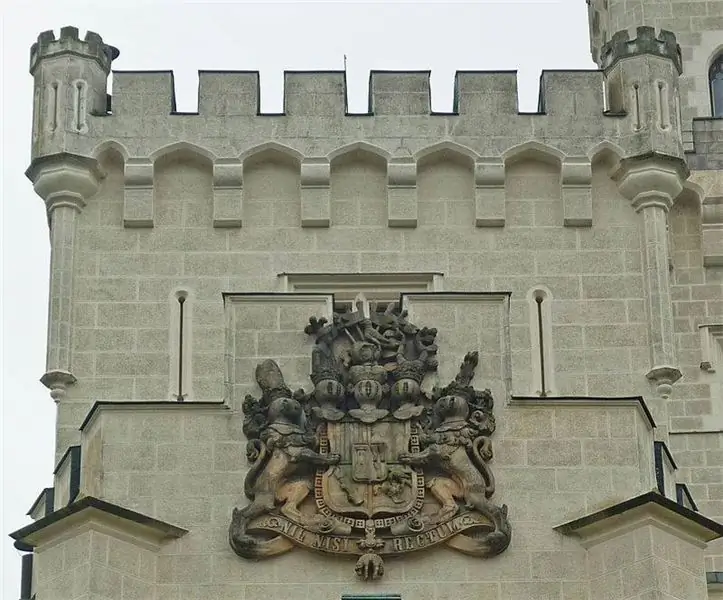
And here is the full Schwarzenberg coat of arms over the main entrance to the castle.
Moreover, although the initiative to rebuild the castle came from her husband, in subsequent years it was his wife, Princess Eleanor, who mainly solved all the issues related to the design of the castle's ceremonial premises, and ordered to remake the already completely finished rooms (for example, the library, the Smoking room or the Morning salon), if those seemed to her not too personable or luxurious. Throughout Europe, including Switzerland, they bought, for example, stained glass windows from churches of the 16th - 17th centuries, which were subject to rebuilding or demolition. Luxurious chandeliers for the rooms were ordered from a glass factory on the island of Murano in Venice, where only expensive antique furniture could be purchased. She also decided to build an arsenal and ordered copies of the damaged paintings to be written instead of simply restoring them. She also initiated the creation of a beautiful castle park and the transformation of the surrounding lands into a magnificent landscape park. By the way, the park around the castle really deserves a walk through it. In it only during one year 1851, 11597 thousand rare species of trees and 2180 shrubs were planted.
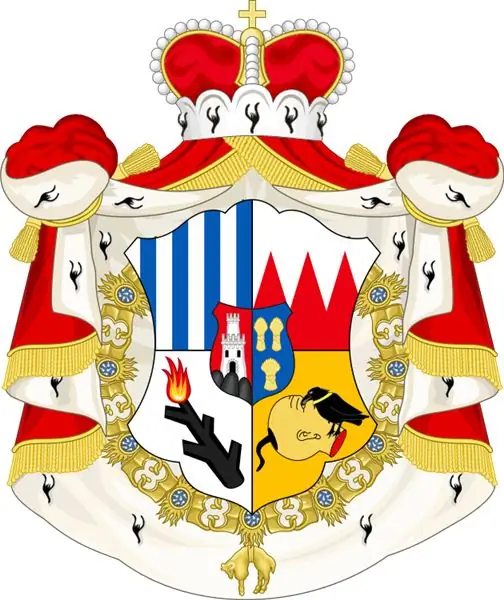
This is how the Schwarzenberg coat of arms looks in color.
Well, now we should talk about personal impressions from visiting this castle, since they are also interesting in their own way. In any case, I dare to hope so. Our tourist bus arrived at the castle early in the morning, and the guide warned us that excursions to the castle are calculated literally in minutes. And you can't be late. You didn’t come in with everyone, you won’t come in at all! Therefore, at first we walked in the park and around the castle, waiting for the appointed hour, or rather, even at 10.37 minutes (that's accuracy!), When we were supposed to be launched there. They are not allowed to enter the castle alone, only in groups. Moreover, the excursions are conducted in a very original way: the text is read out by a tape recorder in your language, which is held in the hands of an accompanying girl. You enter the room - the doors close behind you, then open into the next room, and so on. The route of the excursion is designed so that the groups do not overlap and do not interfere with each other. It's comfortable. The bad news is that you can't take pictures in the castle. Absolutely impossible! For this they are immediately taken out of the castle. However, it is very possible to understand its administration, especially after you follow it! There are a lot of all kinds of valuables, and they have been encroached upon more than once, so that "God takes care of him." Someone takes pictures of carvings, and someone … alarm systems.
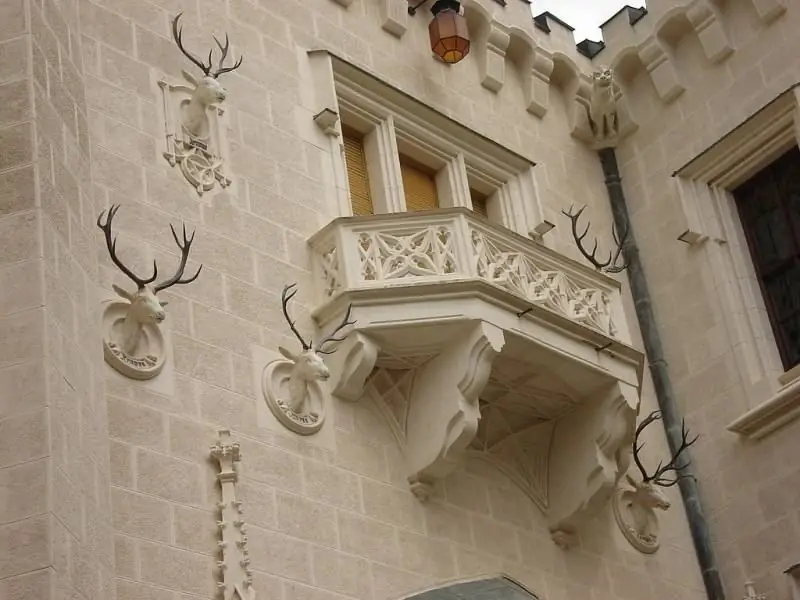
Hunting trophies on the walls of the castle. Original, isn't it? It's good that there was no Green Party at that time.
The tour of the castle begins with a monumental U-shaped arcade staircase leading to the second floor. Portraits along the walls, railings are adorned with delightful carvings, knightly armor of the 16th - 17th centuries flaunts on the walls on stands. It would be nice to take them off, because the armor is very interesting, but, alas, it sees an eye, but a tooth doesn’t need to.
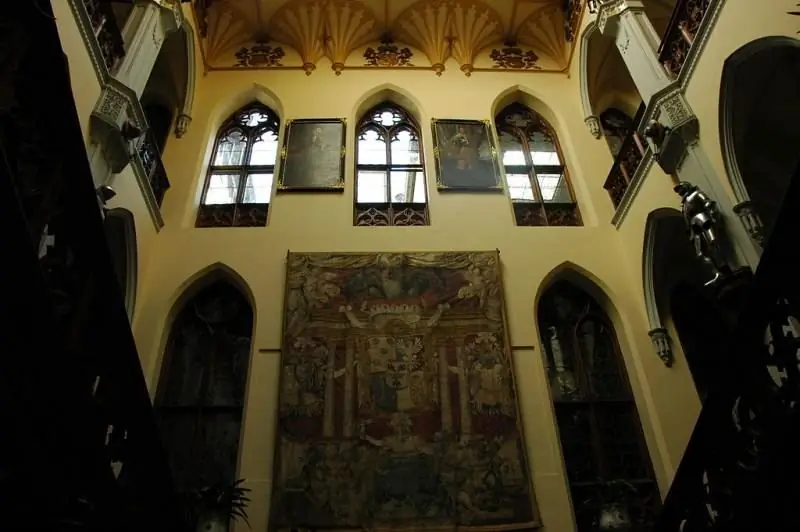
This is the staircase. On the wall directly in front of you are the huge carved doors to the castle's library.
The first room you enter is Princess Eleanor's bedroom. If you have been to the castles of the 15th - 17th centuries, or at least seen their interiors in the movies, then you should, of course, pay attention that the beds of those times were very high and always had a canopy for the canopy, since in winter time there were always very cold. That is, the bed is old, very old and was converted from an old baroque bed to a more modern one according to the sketches of Princess Eleanor. In addition, it is short, because they slept at that time, as a rule, reclining, half-sitting, so as not to suddenly die in a dream! Already in this room, simply gorgeous ceilings are striking. So, in the bedroom, the entire area between the wooden ribs is filled with gilded leather inserts with rich floral designs by the Viennese artist Glaser. The faience stove for heating is designed in such a way that it is heated from the servants' room. In fact, this is … not even a stove, but a real heater!
In the next room of Eleanor - a dressing room, the ceiling is also decorated by this artist. And here also hangs one of twenty 17th century Flemish tapestries, which made up a whole series based on the Aeneid - Aeneas and Dido. It depicts a scene of the flight of Aeneas with his son Ascanio from burning Troy with his old father Anchises on his back. On the left is the figure of a Turk, but this is not surprising, because this is a work of art, and not a textbook on the history of the Ancient World.
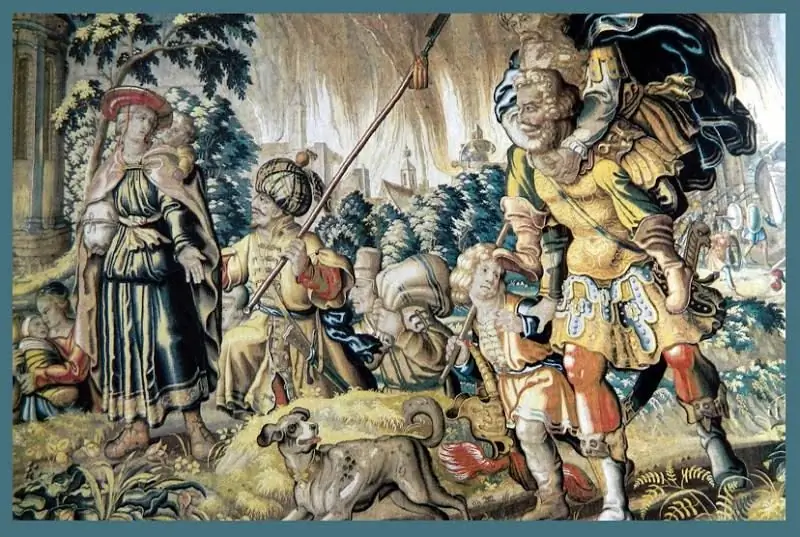
And this is the same tapestry with Aeneas.
Many rooms have fireplaces, and they are absolutely luxurious, like everything else here. However, they were a props, because of which they even had a carved linden cladding, since warm air was supplied to all the ceremonial rooms from huge boilers located in the basement. At the same time, the temperature could even be regulated by opening and closing special dampers.
In the Smoking Room, designed for smoking and board games, a huge white marble fireplace is striking. Its weight is 28 tons, so you can imagine the strength of the castle floors and ceiling supports. At the top of the fireplace are the coats of arms of the Schwarzenberg and Liechtenstein, because Princess Eleanor was née Liechtenstein. Below is a panel with the Schwarzenbergs' motto "NILNISIRECTUM" - "Nothing but Justice".
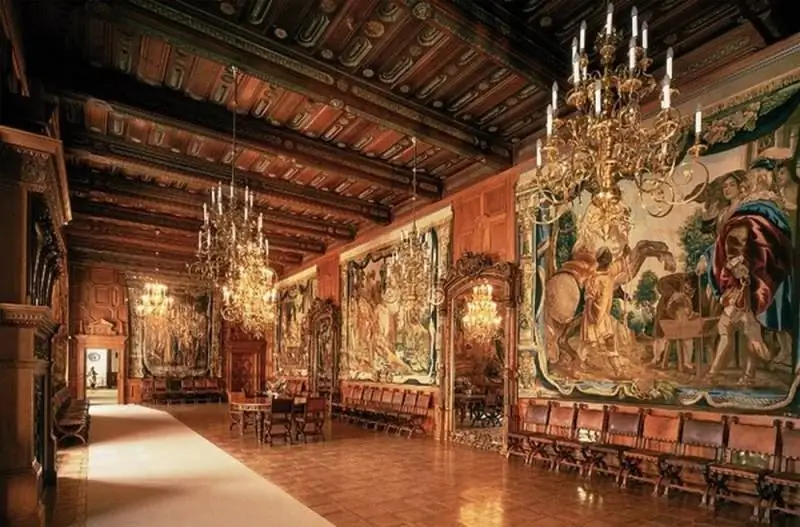
Large dining room. On the walls there are eight tapestries "Riding School", made according to the sketches of the artist Jacob Jordens (1647). There is a round table in the center, but it can be pulled apart so that 72 people can fit behind it at once. Replaceable parts are simply kept in the "back room" for a while.
Looking at the luxury surrounding you, you just … stop in silent admiration and do not believe your eyes. Coffered wood carved ceilings with gilded leather inserts and paintings. Picturesque battles and tapestries and again wood, wood, wood - carved wood all around! The quality of the carving is excellent, and it is a common linden, but … processed to resemble precious woods. And this, not counting paintings in rich frames, all the same tapestries and exceptionally beautiful furniture, some of the samples of which are decorated with brass decorations and richly inlaid with ebony and a tortoise shell. Only on the frame for the large mirror in the reading room, five local carvers worked for 17 months. But it also looks like real lace! In general, the luxury is simply incredible. I have not seen anything like this even in the Hermitage, especially since the rooms here are quite small and all the details of the interior and objects can be seen at close range.
As already noted, the zealous and a bit stingy owner of the castle, Jan-Adolf, collected valuables in the castle in various places. In particular, for the library, which housed 12,000 volumes (!), He bought cabinets in a closed monastery in Würzburg. They were united into one whole with the help of carved inlaid columns with Corinthian capitals, and they were also decorated with 26 carved coats of arms of the former owners of the castle.

Small dining room. Note the impressive coffered ceilings.
Well, there are 140 rooms in the castle, so it is almost impossible to see them all in one excursion. For example, our tour did not include an inspection of the bathrooms, but their equipment is no less interesting than everything else. One of the first bathrooms was built for Princess Eleanor on the first floor under the princess's study. In 1872, the equipping of a new bathroom on the mezzanine began, because “the existing bathrooms of Her Highness the Duchess, due to their basement location, cannot be sufficiently heated so that one could swim there without fear of health, Her Highness graciously ordered them to be moved to a suitable room. in a round tower directly under her study; thoroughly take care of both heating this space below with a hot air heating device and an appropriate supply of cold and warm water. " The new bathroom has been decorated in a "Pompeian style". The latest construction changes in the castle include the construction of a bathroom near the apartments of Princess Hilda, born in Luxembourg and Nassau, which Princess Theresa ordered to build for her daughter-in-law in the 1930s. Two types of hand showers were installed in the bathroom, a toilet with running water, a bidet (when I wrote about this, for some reason I remembered the movie "Crocodile Dundee" and … my first acquaintance with this thing in a regular hotel on "Golden Sands" in Bulgaria in 1968), heated towel rack. By the way, there is interesting information about these towels. For her bathroom, Princess Hilda ordered six Damascus bath sheets, one terry towel, three thin towels, three coarser massage towels, two hand towels, 10 large bath sheets and one rug from Reuss in Luxembourg. For this collection from the prince's cash was paid 3,640 francs, not so expensive, is it?
The well-preserved kitchen, filled with various technical innovations, was also not included in our excursion. In the so-called large and warm kitchen, during the last modernization at the beginning of the 20th century, two large stoves with ovens for different temperatures and a large tank for heating water were installed. Cold snacks were prepared in the cold kitchen, and there were also refrigerators for storing seafood, delicate fruits, dairy products and ice cream, which the princely family loved very much. A separate room was occupied by a bakery with a special oven with several pipes on top of each other, allowing you to adjust the temperature for different types of dough. The kitchen was connected to the living area by a special dumbwaiter. During the autumn hunting season, the number of dishes prepared here increased for 120 guests, and food was also prepared here for the staff.
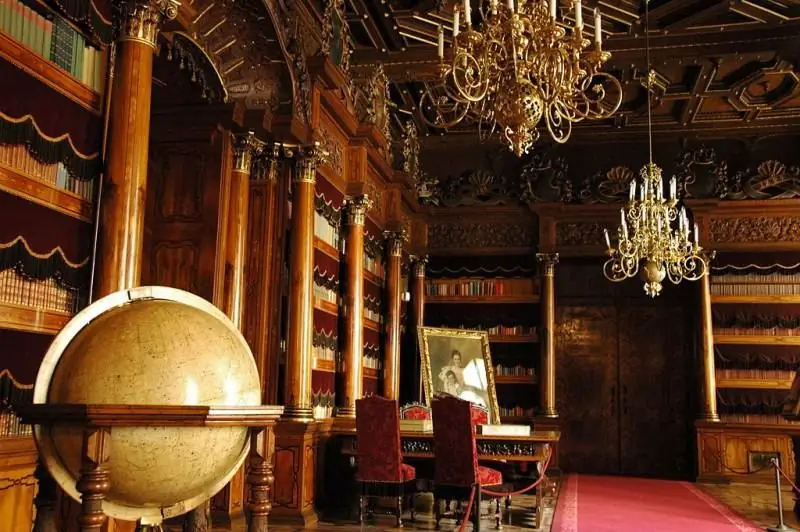
Library.
The most interesting kitchen equipment is the large fireplace with automatic turning of the skewers. The hot air rising through the chimney set in motion special blades that automatically turned the long spits. Up to sixty chickens could be roasted in this fireplace at the same time. Here you can also see the original mechanical mixer of the early twentieth century and an equally original knife from England. It was necessary to insert knives into it and turn the handle. The knives turned out to be sharpened and even polished! Interestingly, almost the same is now in my kitchen. Here are just an electric drive. Progress!
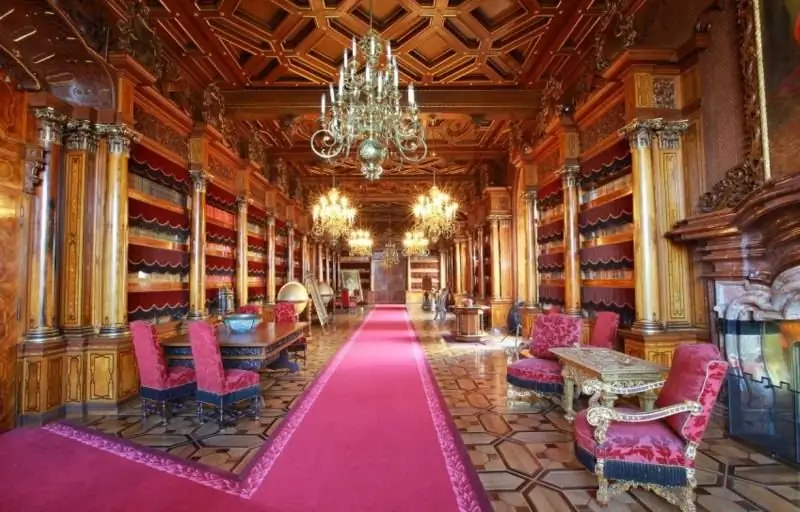
Library again.
In the corridor of the castle I came across a vacuum cleaner called "Atom", released again at the beginning of the twentieth year in the Czech city of Rudnitsa. Most of all, it resembled a Soviet washing machine of the "barrel with a motor" type, except that the drive of this vacuum cleaner was manual, from a large wheel, similar to a ship's steering wheel. Inside were leather furs, which created a strong vacuum due to which this vacuum cleaner worked. Moreover, both the hose and the brush looked quite modern to it, and only by looking closely, one could realize that they are more than 100 years old!
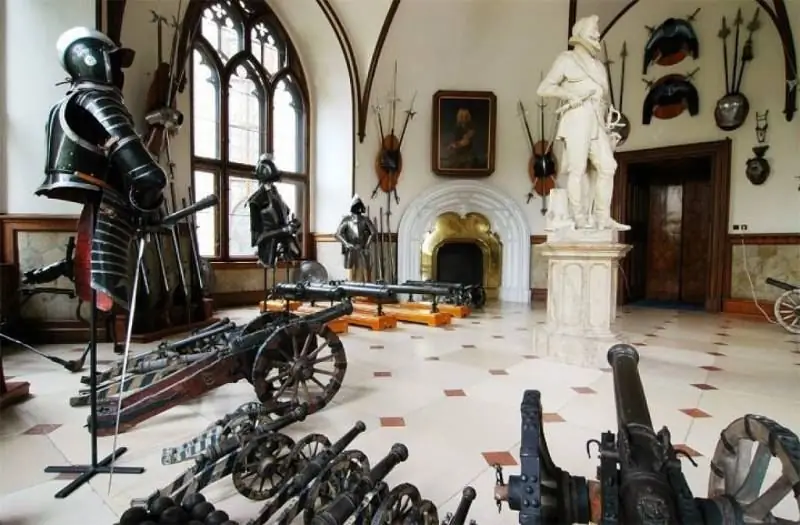
Rondel of the Arsenal.
Naturally, the castle arsenal, containing one of the largest collections of weapons and armor in Central Europe, was of particular interest to me personally. When the residence of the Schwarzenberg princes was rebuilt, it was necessary to confirm the military glory of their ancestors, which is why the most valuable exhibits were concentrated in the arsenal of the Hluboka castle, which were previously stored in the Romanesque Chamber in the Cesky Krumlov castle, where they were first taken from the ancient ancestral residences in Schwarzenberg and Murau. It also included the spoils of war obtained during the siege of Vienna by the Turks in 1683, or bought at auctions in the 19th century. The initial expositions of the romantic arsenal were located only in Rondel - a hexagonal tower to the left of the main gate, but then there were so many exhibits that they "splashed" beyond its limits. For example, the stunning Maximilian armor worn on the "rider" sitting on a horse stands in the corridor at the entrance to Rondel, and there is also similar armor without a horse. The horse has an original knob with a knob with holes for fastening feathers. I saw this for the first time! And neither one nor the other armor is not covered with glass! They are at arm's length and … if only they can be removed here, but this corridor the tourists are carried out quickly enough, so, alas, the rule is not to shoot here even if you want to, and not break it purely physically. But it’s a pity, of course, that I didn’t manage to get photographs of these armor, although after my visit to the castle I turned to his administration with a request to provide them for publication on VO. However, it didn't work out.
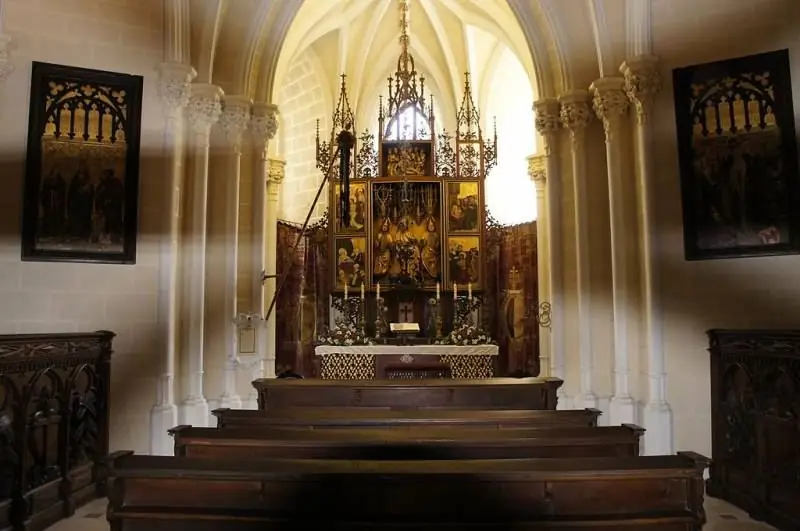
Chapel interior.
The arsenal tower also displays blackened, richly gilded and silvered half-armor made in Augsburg around 1560 by the armourer Hans Ringler, and which most likely belonged to Georg Ludwig Schwarzenberg (1586-1646), who showed his diplomatic talent in the service of the Habsburg. The first among the representatives of his family, he was awarded the Order of the Golden Fleece. Together with Jan Oldřich of Eggenberg, he presented the emperor with a project for the construction of a large Austrian merchant and military fleets and became a successful commander in the war against the Turks on the troubled Croatian border in Varazdin. Despite this, in history he is only mentioned in connection with his first marriage, when in 1617 this wise man, for political reasons, married a five-time (!) 82-year-old widow, after whose death he inherited her rich estate in Styria.
There is so much in the Arsenal. On the ceiling there are pentagonal "stars" made of powder flasks, and the middle of it is also lined with "stars" - "garlic" against the cavalry. For example, an infantry painted shield with a screaming face with … attached to its upper part a lamp with a polished mirror, which illuminated the space in front of the shield, and everything behind it remained in shadow, seemed very original to me, for example. Such shields were intended for night combat and were produced in Italy at the beginning of the 16th century. But the marshal's rod made of narwhal horn, presented after the victory over Napoleon to Karl Schwarzenberg by the Russian Emperor Alexander I, did not impress me. Well, just a white stick with two gold-plated tips and … that's it. I wanted something more … impressive. It’s somehow very simple!

Statue of Marshal Adolf Schwarzenberg.
Armor and half-armor of the Thirty Years War, halberds, swords and sabers, muskets and pistols, miniature models of guns - "samples" (samples shown to the customer instead of real guns) and much more are also exhibited here. In the middle of the tower stands a statue of Field Marshal Adolf Schwarzenberg, a hero of the war against the Turks, who took the Ottoman fortress Raab (in Hungary) in 1598, for which Emperor Rudolph II awarded him the title of imperial count and allowed him to include in his coat of arms the head of a Turk, which a raven bites in the eye! A disgusting plot, which, by the way, is constantly encountered in the castle, but such were their morals then!

Well, I first saw this hybrid dagger-pistol from the Thirty Years War in the arsenal's exposition, and then in a souvenir shop in the town of Gluboka, and I just couldn't help but buy it as a keepsake. It was made very close to the original, and besides, it also … "clicks". The steel on the blade, of course, is not steel at all, and there is no ignition hole on the barrel, but the police will not pick on - a souvenir is a souvenir.
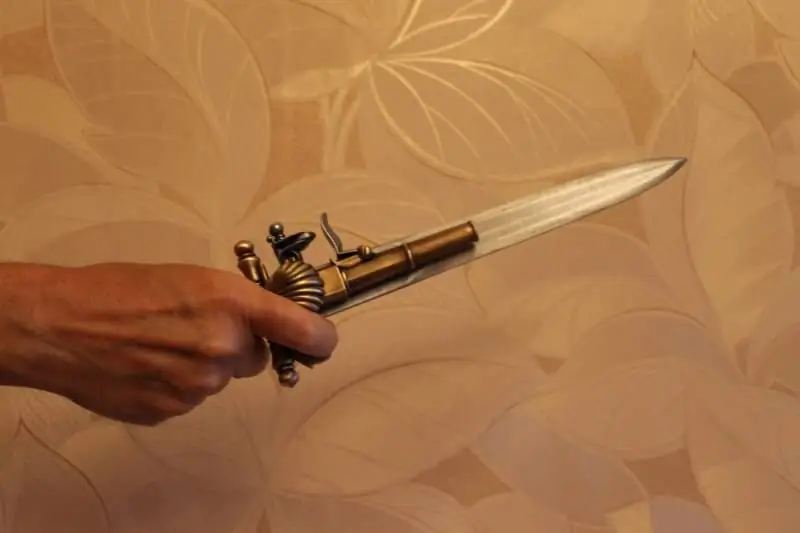
In the hand, this "piece" is, by the way, very comfortable. It is not for nothing that there are several such daggers on display in the arsenal. Apparently, this weapon was quite common. Now I will open letters to them …
I should have stayed in the castle a little longer, but, alas, the excursions continue strictly in time, so that was the end of it, and we, full of impressions of the luxury of everything we saw, left its white walls …






